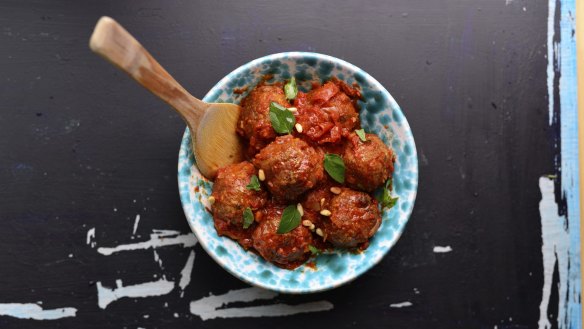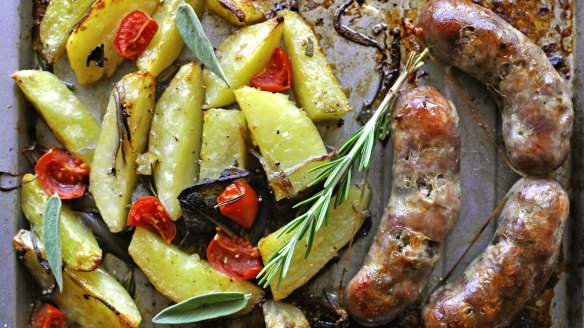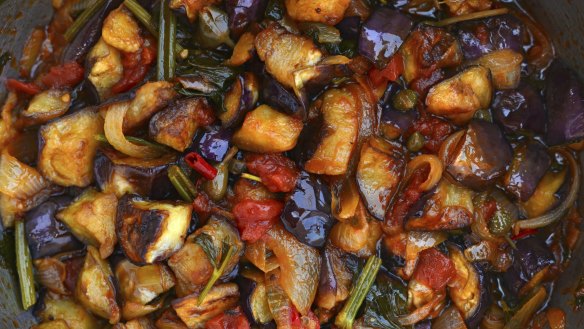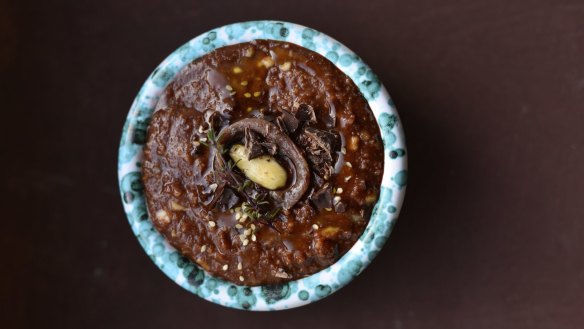Three rustic Italian recipes from The Sicily Cookbook

While only a few kilometres from the rest of Italy, Sicily has a proud heritage distinct from that of the mainland, favouring dishes packed with spices, citrus fruits, cheeses, olives, tomatoes, eggplant and seafood.
The Sicily Cookbook by Sicilian cook, writer and photographer Cettina Vicenzino features three strands of Sicilian cooking – cucina povera (peasant food), cibo di strada (street food), and cucina dei monsu (sophisticated food) – alongside profiles on local chefs and food heroes.

Let your cooking burst with Mediterranean sunshine with these three recipes from the celebrated island.
Sweet meatballs with almonds and cinnamon (Polpette dolci)
Polpette are hugely popular in Sicily and made with all kinds of different ingredients, such as eggplants, ricotta or simply with flavoured fresh breadcrumbs. These sweet polpette are inspired by a recipe from Maria Grammatico in her book Bitter Almonds. She describes that, in the post-war years, polpette dolci were the favourite festive treat served to children at the San Carlo abbey. The nuns certainly bulked out the meat in their polpette with quite a lot of breadcrumbs; Maria halved the quantity in her recipe. The raisins used here would have been those that weren't quite good enough for making dessert.
INGREDIENTS
For the sauce
- 2 tbsp extra virgin olive oil
- 1 large onion, finely chopped
- 1 large garlic clove, finely chopped
- 1 heaped tbsp tomato paste
- 700g passata
- 1 cinnamon stick
- sea salt and freshly ground black pepper
For the meatballs
- 70g blanched almonds
- 20g sugar
- 100g fresh breadcrumbs
- 140ml milk
- 480g minced beef
- 80g pecorino cheese, finely grated
- 30g raisins
- 20g pine nuts, plus extra to serve
- 1½ tsp ground cinnamon
- chilli flakes
- 2 medium eggs
- extra virgin olive oil
- oregano leaves, to serve
METHOD
- To make the tomato sauce, heat the olive oil in a pan over a medium heat and fry the onion with the garlic without letting them take on any colour. Stir in the tomato paste along with 400ml of hot water, bring to the boil, then simmer everything for 1 minute. Stir in the passata and cinnamon stick, season with salt and pepper, and simmer for about 10 minutes.
- Meanwhile, to make the meatballs, blitz the almonds and sugar in a food processor until the almonds are reduced to little chunks with just a bit of texture. Soak the breadcrumbs in the milk in a bowl for 20 minutes. Combine the almond mixture and breadcrumbs with the meat, cheese, raisins, pine nuts, and ground cinnamon in a bowl. Season with salt, pepper, and chilli. Now stir in the eggs one at a time. The mixture should not be too firm or too soft.
- Heat some olive oil in a frying pan over a medium heat. Use your hands to form 16 meatballs from the mixture. Fry them in the hot oil until golden brown on all sides, then transfer the meatballs to the tomato sauce and simmer gently for another 20 minutes. If the sauce becomes too thick, add some boiling water.
- Take 4 deep plates and arrange 4 meatballs and some sauce on each. Scatter each with oregano leaves and pine nuts, grind over some black pepper, and serve drizzled with a dash of olive oil.
Serves 4

Sicilian pork sausages baked with potatoes (Salsiccia al forno con patate)
Sicilians' favourite way to eat pork is in the form of salsiccia, preferably made traditionally using wild fennel seeds and meat from black pigs reared in the Nebrodi mountains. Don't confuse fennel sausages from Tuscany with the Sicilian variety. They are completely different when it comes to appearance, taste, and ingredients. Tuscan salsiccia al finocchio is often made using bardiccio fiorentino, a strongly spiced sausage made from beef and pork, which also includes fennel seeds. If you can't find Sicilian-style sausages, use chunky pork sausages instead.
INGREDIENTS
- extra virgin olive oil
- 600g waxy potatoes, peeled
- 1 red onion, finely sliced
- sea salt and freshly ground black pepper
- 8 Sicilian sausages with fennel, or chunky pork sausages
- 8-10 cherry tomatoes, stalks removed, quartered
- 6 sage leaves, roughly torn
- 2 rosemary sprigs
METHOD
- Preheat the oven to 180C fan-forced (200C conventional). Oil a baking tray, or line it with baking parchment.
- Cut the potatoes in half lengthways, then slice each half into thirds. Toss the potatoes and onion in a bowl with some salt and pepper and sufficient olive oil to coat everything well. Mix with your hands, then spread the vegetables out on the prepared tray.
- Prick the sausages all over with a toothpick and place these on the tray, too. Drizzle the sausages with a small amount of olive oil and slide the tray into the middle of the oven. Toss the vegetables occasionally, and turn the sausages after 15-20 minutes cooking. After about 30 minutes, stir in the tomatoes, sage, and rosemary, season sparingly with salt and continue cooking for about another 10 minutes.
- The potatoes and sausages are done when they have turned slightly golden. Remove from the oven and serve.
Serves 4

Caponata with eggs and St Bernardo sauce (Caponata con uova sode e sarsa di San Birnardu)
The most famous of all dishes in Sicilian cuisine! In 1869, the Pensabene family began to produce caponata on an industrial scale. Sales were particularly successful in America, on account of the number of Sicilian immigrants there. Contrary to common belief, the eggplant doesn't have to go it alone in this dish, there are plenty of other wonderful combinations. The aristocratic version would have been served with fish, but nowadays the more frugal vegetarian version is the most widely found. I serve this caponata following an ancient – and now uncommon – recipe using St Bernardo sauce and eggs.
INGREDIENTS
- 1 portion St Bernardo sauce (see below)
- extra virgin olive oil
- 2 eggplants, chopped into 4-5cm pieces
- 1 large red capsicum, cut into in 4-5cm pieces
- 1 large onion, finely chopped
- 2 tbsp small capers
- handful of green olives, pitted
- 1 red chilli, chopped
- 1 celery stick, chopped
- 400g ripe tomatoes
- 1 tbsp chopped basil leaves
- sea salt
- 25-30g sugar
- 125ml white wine vinegar
- 8 medium eggs, hard-boiled and shelled
METHOD
- Prepare the St Bernardo sauce (see below).
- Heat some olive oil in a pan over a high heat. Saute the eggplants first until partially cooked, then set aside. Add more oil if needed and saute the pepper until partially cooked in the same way, then set aside.
- Heat some olive oil in a large saucepan and saute the onion with the capers, olives, chilli, and celery.
- Meanwhile, remove and discard the stalks from the tomatoes and place in a large bowl. Pour over boiling water from the kettle to just cover and leave for 30 seconds, then drain. The skins should slip off. Remove the skins and chop the flesh finely. Add them to the pan with the onion mixture and let them simmer down slightly. Add the partially cooked eggplant and pepper pieces with the basil, season with salt, and simmer until the vegetables are cooked. Combine the sugar and vinegar in a small bowl, stir this in, and let everything continue to simmer for another 5 minutes.
- Remove from the heat and leave to cool until lukewarm.
- Divide between 4 plates, add a couple of hard-boiled eggs to each and serve with the St Bernardo sauce.
Serves 4
Note: The flavours will be even better if the dish is prepared a day in advance. Just reheat it slightly and serve lukewarm, or even at room temperature, but not cold from the refrigerator, which will numb all the flavours.

St Bernardo sauce (Sarsa di San Birnardu)
This is an unusual sauce dating back to ancient times, and confirms the Sicilian passion for powerful contrasts. It is thought that it was invented by Benedictine monks from Catania. It is delicious, and embodies a flavour we now know as umami. But today the sauce is far less common on the island. During the Monsu period it would have been served alongside caponata, albeit a more lavish version of the dish than my own recipe. The sauce also goes well with artichokes, eggs and meat.
INGREDIENTS
- 120g blanched almonds
- 50g dried breadcrumbs
- 6 anchovies in oil
- 50g castor sugar, or honey, plus extra to taste
- 3 tbsp extra virgin olive oil, plus extra to taste
- 80ml freshly squeezed orange juice, plus extra to taste
- 60ml cider vinegar, plus extra to taste
- 70g dark chocolate
METHOD
- Lightly toast the almonds in a dry pan, leave until cool enough to handle, then chop quite finely.
- Meanwhile, lightly toast the breadcrumbs in a dry pan and mix these with the almonds in a bowl.
- Finely chop the anchovies and combine with the sugar. Mix this with the olive oil and orange juice, then stir it into the almond mixture. Gradually stir in the vinegar.
- Melt the chocolate over a bain-marie (in a heatproof bowl over a saucepan of simmering water, making sure the bowl does not touch the water), then stir this into the sauce. For my tastes the sauce is now ready. However, if desired, you can adjust the flavour with additional sugar, oil, orange juice and vinegar. The sauce should have a consistency similar to pesto.
- Store in the refrigerator for about 1 hour before serving, to allow the flavours to develop. Then serve lukewarm with vegetables or meat.
- If covered with cling film, the sauce will keep in the refrigerator for about 3 days. Ideally warm it gently over a bain-marie before serving.
Serves 4
This is an edited extract from The Sicily Cookbook by Cettina Vicenzino, published by Dorling Kindersley. RRP $34.99. Buy now.